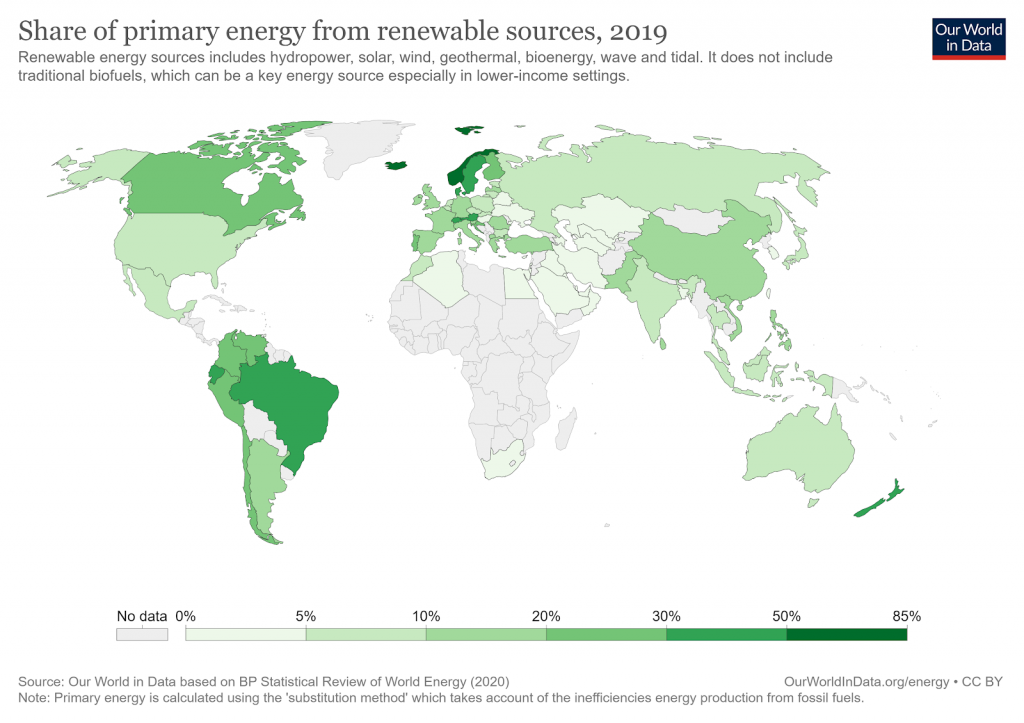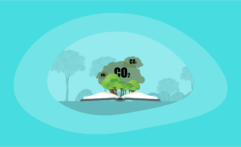Renewable Energy vs Alternative Energy: What’s the Difference?
Impactful Ninja is reader-supported. When you buy through links on our site, we may earn an affiliate commission.
Learn more
Learn more
.
Hey fellow impactful ninja ? You may have noticed that Impactful Ninja is all about providing helpful information to make a positive impact on the world and society. And that we love to link back to where we found all the information for each of our posts. Most of these links are informational-based for you to check out their primary sources with one click. But some of these links are so-called "affiliate links" to products that we recommend. First and foremost, because we believe that they add value to you. For example, when we wrote a post about the environmental impact of long showers, we came across an EPA recommendation to use WaterSense showerheads. So we linked to where you can find them. Or, for many of our posts, we also link to our favorite books on that topic so that you can get a much more holistic overview than one single blog post could provide. And when there is an affiliate program for these products, we sign up for it. For example, as Amazon Associates, we earn from qualifying purchases. First, and most importantly, we still only recommend products that we believe add value for you. When you buy something through one of our affiliate links, we may earn a small commission - but at no additional costs to you. And when you buy something through a link that is not an affiliate link, we won’t receive any commission but we’ll still be happy to have helped you. When we find products that we believe add value to you and the seller has an affiliate program, we sign up for it. When you buy something through one of our affiliate links, we may earn a small commission (at no extra costs to you). And at this point in time, all money is reinvested in sharing the most helpful content with you. This includes all operating costs for running this site and the content creation itself. You may have noticed by the way Impactful Ninja is operated that money is not the driving factor behind it. It is a passion project of mine and I love to share helpful information with you to make a positive impact on the world and society. However, it's a project in that I invest a lot of time and also quite some money. Eventually, my dream is to one day turn this passion project into my full-time job and provide even more helpful information. But that's still a long time to go. Stay impactful,Affiliate Disclosure
Why do we add these product links?
What do these affiliate links mean for you?
What do these affiliate links mean for us?
What does this mean for me personally?
![]()
Renewable and alternative energy are often used interchangeably to describe substitutes for fossil fuels that are better for the environment. And while some people will argue that they both are the same thing, this is only true for some of these energy sources. But knowing what their differences are will help you make a more informed energy choice. So we had to ask: What’s the difference between renewable and alternative energy?
Renewable energy generation comes from sources that can be replenished naturally over time. Alternative energy generation does not produce greenhouse gases or harm the environment. These differences are important when discussing ways to fight global climate change.
So if they really are different, how do we differentiate between renewable and alternative energy? How can one energy type be only renewable OR alternative but another energy type be both renewable AND alternative? Below we will break down the individual definitions, categorize certain energy types, and discuss what this means in the context of our environment.
How Are Renewable Energy and Alternative Energy Defined
Without a doubt, there is a lot of overlap between renewable and alternative energy. Sometimes those words are even used synonymously. But there are differences between these two that become important when talking about the effects they have (or don’t have) on our environment.
What Does the Dictionary Say About Renewable Energy and Alternative Energy
Both renewable and alternative energy sources aim to reduce global greenhouse gas emissions by providing a substitute for fossil fuels (e.g. coal and oil).
“Renewable Energy: energy that is produced using the sun, wind, etc., or from crops, rather than using fuels such as oil or coal | types of energy that can be replaced naturally such as energy produced from wind or water”
Cambridge Dictionary
Renewable energy is sustainable because the energy sources are in infinite supply, and we can keep harvesting them for years to come.
“Alternative Energy: electricity or power that is produced from the sun, wind, water, etc. in ways that do not use up the earth’s natural resources or harm the environment”
Oxford Dictionary
Alternative energy does not produce greenhouse gas emissions that contribute to global warming or cause substantial harm to the environment.
The key factor separating the two is that some renewable energy sources can harm the environment, whereas alternative energy sources do not pollute or harm the environment.
What Do These Differences Between Renewable and Alternative Energy Mean
The subtle but significant differences between renewable energy and alternative energy have different implications on our environment:
- If energy is only renewable but NOT alternative: the energy source supply is infinite, but the generation of energy does produce greenhouse gases or harm the environment. For example, wind power is renewable, but wind turbines pose a threat to flying wildlife, and the land use requirement for wind farms is very high.
- If energy is only alternative but NOT renewable: The generation of energy does not produce greenhouse gases or harm the environment, but the energy source supply is finite. For example, nuclear energy does not harm the environment or produce greenhouse gases, but there is a finite amount of Uranium required in the generation of nuclear energy.
In short, renewable energy comes from resources that are in infinite supply but have the potential to harm our environment. Alternative energy does not harm the environment or pollute the atmosphere.
What Are the Differences and Similarities Between Renewable Energy and Alternative Energy
Renewable and alternative energy sources aid in the fight against global climate change because they help curtail greenhouse gas emissions. The most efficient way to do this is to utilize energy sources that are both renewable and alternative.
| Energy type | Energy source |
| Both Renewable and Alternative Energy | Solar Geothermal |
| Only Renewable but not Alternative Energy | Biomass Hydropower Wind |
| Only Alternative but not Renewable Energy | Nuclear |
To categorize an energy source as either renewable, alternative, or both we must examine if the source is infinite, if greenhouse gases are produced during energy generation, and if the environment is negatively impacted.
Which Energies Are Both Renewable Energy and Alternative Energy
If energy is both renewable AND alternative, the energy source is in infinite supply, and the generation of energy does not produce greenhouse gases or harm the environment. Below are the energy sources that are both renewable and alternative.
- Solar Energy: photovoltaic cells (PVC) in solar panels absorb energy from sunlight, creating an electrical charge that moves in response to an internal electric field in the cell and creates electricity. This process is renewable because the sun will continue to emit energy until it goes supernova. It is also alternative because no greenhouse gases are emitted during operation and it does not harm the environment. Following proper disposal methods of hazardous chemicals associated with PVCs and placing solar panels in less populated areas or on top of buildings minimizes any negative environmental impacts.
- Geothermal Energy: drilling down to hot water reservoirs creates steam that rotates a turbine, which spins a generator to generate electricity. Geothermal is renewable because the Earth has an almost unlimited supply of heat generated by its core, and the water extracted from the reservoirs can be recycled via re-injection into the ground. It is also alternative because it produces only a minute amount of greenhouse gases and minimizes any negative environmental impacts by only drilling to shallow depths and by recycling the water used.
Solar and geothermal are both renewable and alternative energies because the energy source supply is infinite and their generations do not produce greenhouse gases or damage the environment.
Which Energies Are Only Renewable Energy But Not Alternative Energy
If energy is only renewable but NOT alternative, the energy source is in infinite supply, but the generation of energy either produces greenhouse gases or harms the environment. Below are the energy sources that are renewable but not alternative.
- Biomass: Wood, agricultural crops, biogenic materials, animal manure, and human sewage contain stored chemical energy from the sun which is burned for heat or converted to fuel. This process is renewable because it can be replenished by planting trees and agricultural crops. It is not alternative though because the combustion of biomass materials releases sequestered carbon dioxide, nitrogen oxides, and sulfur oxides into the atmosphere. The biomass industry is also responsible for clearcutting forests and reducing both plant and animal biodiversity.
- Hydropower: Flowing water turns turbines, which spins a generator to generate electricity. This process is renewable because the water cycle is a continuous process that recharges itself. It is not alternative though because hydropower produces greenhouse gas emissions via the construction of hydroelectric facilities and biomass decomposition in the reservoirs. Also, dams that create reservoirs can obstruct fish migration, alter the water temperature and chemistry, divert river flow patterns, affect silt loads, and flood out adjacent lands.
- Wind Power: wind turns the blades of wind turbines around a rotor, which spins a generator to generate electricity. This process is renewable because as long as the wind blows, wind power can be harnessed. It is not alternative though because spinning turbine blades pose a threat to flying wildlife, and the land use requirement for wind farms is very high.
Geothermal, biomass, hydropower, and wind are all examples of renewable energy but not alternative energy because their energy production negatively impacts the environment in some way.
Which Energies Are Only Alternative Energy But Not Renewable Energy
If energy is only alternative but NOT renewable, the generation of energy does not produce greenhouse gases or harm the environment, but the energy source supply is finite. Below are the energy sources that are alternative but not renewable.
- Nuclear Energy: in nuclear fission, an enormous amount of energy is released when electromagnetic radiation is used to split the nucleus of a Uranium atom (U-235). Nuclear energy is not renewable though because there is a finite supply of U-235 found on Earth. But it is alternative because this process does not harm the environment or produce greenhouse gases (not counting any accidents).
Nuclear power plants use the second most common isotope of Uranium (U-235) which has a relative abundance of only 0.7%. Since it has a half-life of about 700 million years, most of the original U-235 on earth has already decayed, making nuclear energy a nonrenewable energy source.
Why Is it Important to Differentiate Differences Between Renewable and Alternative Energy
Although they come with numerous benefits, renewable and alternative energies also have drawbacks that should be noted. Understanding these drawbacks and differentiating between the differences can inform policy and help us make better decisions when protecting our environment.
| Renewable Energy | Alternative Energy | |
| Benefits | Infinite energy supply, promotes decentralization; potentially no greenhouse gas emissions and non-polluting | No greenhouse gas emissions, non-polluting, does not harm the environment |
| Drawbacks | Some can negatively impact the environment and have intermittent production, geographic limitations, lower quantities of energy produced | Some have intermittent production, geographic limitations, or nuclear waste byproducts |
Renewable energy is by definition infinite because the resources naturally replace themselves over time. It is also mostly non-polluting, low-maintenance, and promotes the decentralization of energy supply. On the flip side, renewable energy comes with some of the same drawbacks that alternative energy comes with, minus the threat of nuclear waste but with lower immediate quantities of energy compared to non-renewable energy sources (e.g., coal and oil).
Alternative energy does not produce greenhouse gases or negatively impact the environment, making it a good alternative to fossil fuels. On the other hand, it can have intermittent production and geographic limitations which could benefit from technology such as the smart grid. The disposal of nuclear waste and containment of radioactive material are other issues that need to be addressed when considering implementing this energy source.
Yes, both renewable and alternative energies each have their drawbacks. But they also play a crucial role in combating our current global climate crisis.
How Do Renewable and Alternative Energy Benefit the Environment
Here are three ways in which renewable energy and alternative energy can aid in the fight against global climate change:
- Climate Change Mitigation: alternative energy does not emit carbon dioxide, nitrogen oxides, sulfur dioxides, or mercury into the atmosphere, soil, or water. These pollutants are known to contribute to the thinning of the ozone layer, global sea-level rise, and the melting of our world’s glaciers. Alternative energy also does not negatively impact the land, water, or biodiversity of our environment.
- Energy Independence: Being able to produce our own electricity in the U.S. without the aid of foreign countries is an important step to help us become more self-sufficient instead. Former President George W. Bush signed the Energy Independence and Security Act of 2007 to reduce U.S. dependence on oil, expand the production of renewable fuels (and confront global climate change).
- Employment Opportunities: The renewable energy sector employed 11.5 million people worldwide in 2019, with solar energy making up the bulk of those jobs. Renewable energy jobs continue to increase as we start to realize just how beneficial renewable energy is for our environment.
However, we still have a long way to go to make renewable or alternative energy sources our primary form of energy. Only a very few countries have renewables as their primary energy source, while the vast majority of countries are still very far off.
Most countries generate only a small percentage of their energy from renewables. In 2019, the U.S. generated 8.71% of its energy from renewables. In the same year, Iceland generated 79.08%. The large disparity between the two is an indication of just how far off we are from making renewables our primary source of energy.

Final Thoughts
Renewable and alternative energy should not be used synonymously because they are not the same thing! Although some renewable energy can also be classified as alternative, and vice versa, not all energy can be classified as both. Choosing the correct term when talking about the fight against global climate change is important because the terms have different meanings. The goal of renewable energy is to use energy sources that will not run out, and the goal of alternative energy is to not pollute the atmosphere or harm the environment.
The drawbacks of both energies should be noted, but they should not be the deciding factor on whether or not to use renewable or alternative energy. Both significantly cut down on greenhouse gas emissions when compared to fossil fuels, and both seek to minimize our environmental impact.
Stay impactful,

Sources
- Natural Resources Defense Council: Renewable Energy – The Clean Facts
- New World Encyclopedia: Alternative Energy
- High Country Conservation Center: What’s the Difference Between Clean & Renewable Energy?
- Office of Energy Efficiency and Renewable Energy: How Does Solar Work?
- Union Of Concerned Scientists: Environmental Impacts of Solar Power
- Office of Energy Efficiency and Renewable Energy: Geothermal FAQs
- National Renewable Energy Laboratory: Geothermal Electricity Production Basics
- Brittanica: Environmental Effects And Economic Costs
- U.S. Energy Information Administration: Biomass Explained
- Natural Resources Defense Council: Biomass – Not Carbon Neutral and Often Not Clean
- Leonardo DiCaprio Foundation: Dangerous delusions – biomass is not a renewable energy source
- Office of Energy Efficiency and Renewable Energy: How Hydropower Works
- Synapse Energy Economics Inc.: Hydropower Greenhouse Gas Emissions
- U.S. Energy Information Administration: Hydropower and the environment
- Union Of Concerned Scientists: Environmental Impacts of Hydroelectric Power
- Office of Energy Efficiency and Renewable Energy: Advantages and Challenges of Wind Energy
- Office of Energy Efficiency and Renewable Energy: How Do Wind Turbines Work?
- Office of Energy Efficiency and Renewable Energy: Environmental Impacts and Siting of Wind Projects
- National Geographic: Non-Renewable Energy
- Brittanica: Nuclear Fission
- World Nuclear Association: Uranium Mining Overview
- Scholar Schools: Advantages and Disadvantages
- Impactful Ninja: How Does the Smart Grid System Benefit the Environment
- White House Archives: Fact Sheet – Energy Independence and Security Act of 2007
- International Renewable Energy Agency: Renewable Energy Jobs Continue Growth to 11.5 Million Worldwide
- U.S. Energy Information Administration: Renewable Energy Explained
- Our World in Data: Share of Primary Energy From Renewable Sources




